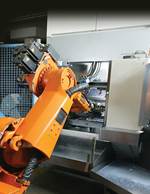Inconsistent Results from Passivation
Is improper heat treating the more likely culprit?
Q. I have passivated the same part, made from 416 SS, in my Nitric/Sodium Dichromate bath a couple of times. On one occasion the parts were attacked and subsequently became scrap. The parts—a few days before and a few days after—were all OK. I document the percentages Nitric Acid on a weekly basis and everything is within specifications (ASTM A-380 Code G). Why would the one batch get attacked and not the others? After having the material analyzed the only major differences in the chemical composition is 0.3% Manganese higher in the attacked parts and 0.25% higher in Copper as well. Could this be the problem? Is improper heat treating the more likely culprit? Any help would be greatly appreciated. A.C.
A. I would look at the temperature control from the company performing your heat treating first. The 416 grade of stainless steel is in the martensitic stainless steel family. This is similar to the ferritic grade in that it uses chromium to provide corrosion resistance, however, the carbon content is higher than the ferritic grades that allow the martensitic grades to be heat treated. Within this category, the 416 is considered to have relatively low carbon content, but can still suffer from embrittlement and loss of corrosion resistance if improperly heat treated.
Between about 700–1,000°F, the martensite transforms into ferrite and iron carbide which will also tend to tie up some of the chromium making the stainless steel significantly less corrosion resistant. This would explain the attack you see in the acidic passivation bath. Instead of forming chromium oxide and dissolving impurities, the solution will attack all the areas of the grains where the chromium is depleted and will no longer be stainless steel in those locations. Also, if heat treatment occurs in this region, the material will also show a loss in ductility and toughness.
I am guessing you are sending your parts out for tempering or annealing which is the next temperature range higher than the problem range I mentioned above. It could be that the company performing your heat treating is feeling the energy pinch like everybody else and operating their furnace on the lower end of their specification range to save money. By doing that, some of the parts may lag others and never reach the correct temperature. This would be the worst possible point to let that happen, too, since the loss in corrosion resistance will grow in this temperature region (700–1,000°F) and tend to peak at about 950°F. You would want your parts to get to about 1,400–1,500°F to make sure they fully transition out of this range. You will have to work with your heat treating service to understand how they process the parts including handling, racking, furnace temperature profile and finally validating that your parts receive enough heat in that load. Generally, the coldest spot in a heat treat furnace is near the bottom and by the door, especially if shielded from the heating elements. You will need to have the coldest part temperature profiled in order to insure that this is not happening. Correcting this will likely solve your passivating problems.
Related Content
Maximize Your Racking Efficiency and Quality
Best practices for racking parts in surface finishing operations.
Read MoreFABTECH 2024 Heads to Orlando
CCAI’s FINISHING Pavilion and Conference continues to grow at FABTECH, offering insights and innovations covering all aspects of industrial surface finishing.
Read MoreTroubleshooting 5 Common Racking Problems for Platers
Being aware of usual issues that might occur during the plating process will prepare platers by helping them know how to avoid them all together or how to fix them if they happen.
Read MoreFilm Thickness Control
Have a powder coating job that requires precise film thickness control? Products Finishing columnist Rodger Talbert offers advice controlling the variables that can impact your success.
Read MoreRead Next
Passivation Basics
What is commonly referred to as "passivating" on a shop floor is actually just enhancement of a naturally occurring process on most stainless steels.
Read MoreEpisode 45: An Interview with Chandler Mancuso, MacDermid Envio Solutions
Chandler Mancuso, technical director with MacDermid Envio discusses updating your wastewater treatment system and implementing materials recycling solutions to increase efficiencies, control costs and reduce environmental impact.
Read MoreEducation Bringing Cleaning to Machining
Debuting new speakers and cleaning technology content during this half-day workshop co-located with IMTS 2024.
Read More
















.jpg;maxWidth=300;quality=90)









